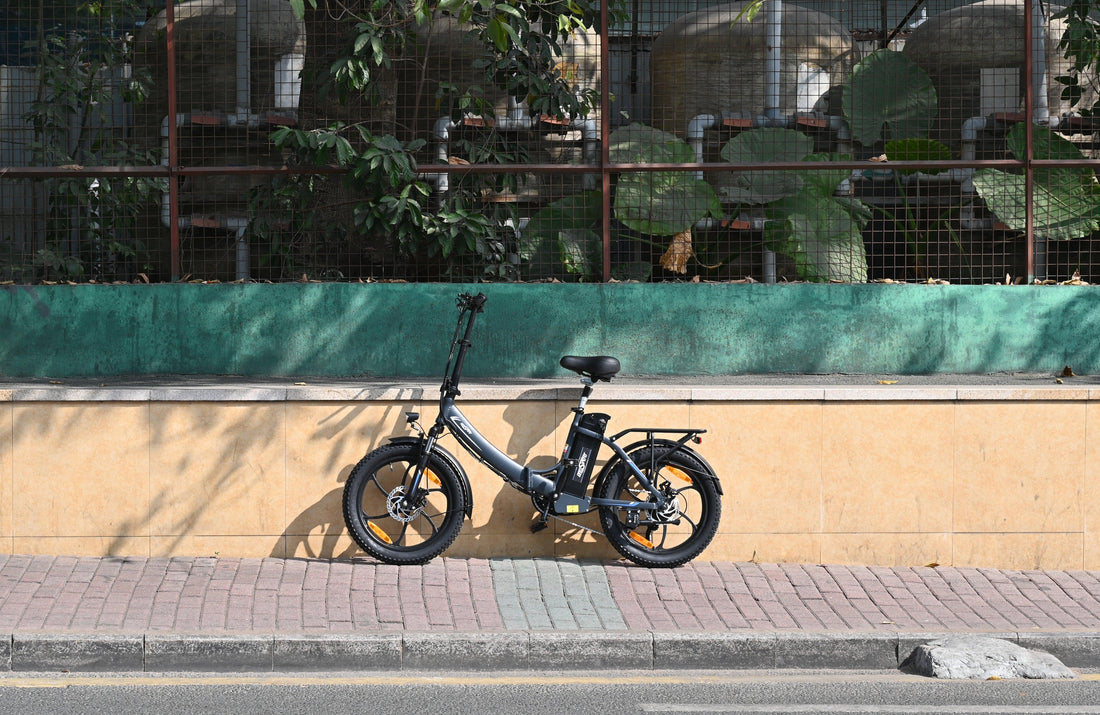Electric bicycles (e-bikes) have revolutionized urban mobility, offering an eco-friendly alternative to traditional transportation methods. However, as their popularity surges, concerns regarding their safety, especially pertaining to their batteries, have become increasingly prominent. This article provides an in-depth analysis of e-bike safety, focusing on both the general aspects of these vehicles and the specific safety considerations related to their battery systems.
Understanding E-Bike Safety
Structural Integrity
E-bikes are designed to withstand the additional weight and speed generated by their electric components. This includes reinforced frames, durable tires, and robust suspension systems that provide stability and absorb shocks.
Braking Systems
Given the increased speeds e-bikes can achieve, they are often equipped with advanced braking systems. Hydraulic disc brakes are common, offering efficient stopping power and better control, especially in wet conditions.
Lighting and Visibility
E-bikes are usually fitted with LED lights for enhanced visibility. Reflective materials and high-visibility colors are also used to ensure the rider is seen by other road users.

Speed Limiters and Control Systems
Most e-bikes come with speed limiters to comply with regional regulations. These systems also include various modes to control power output, adapting to different riding conditions.
Advanced Battery Technologies in E-Bikes
Lithium-Ion Technology Evolution
The lithium-ion batteries in e-bikes have evolved significantly over the past few years. The latest iterations offer higher energy densities, allowing for longer rides on a single charge. Moreover, improvements in cathode and anode materials have enhanced their overall safety and lifespan.
Battery Cell Composition
Understanding the cell composition is critical. Most e-bike batteries use Lithium Nickel Manganese Cobalt Oxide (NMC) or Lithium Iron Phosphate (LFP) cells. NMC cells provide a good balance between energy density and safety, while LFP cells, though heavier, offer longer lifespans and better thermal stability.
Battery Voltage and Capacity
The typical voltage of e-bike batteries ranges from 24V to 48V, with some high-performance models reaching up to 72V. Capacity, measured in ampere-hours (Ah), varies, with higher capacities offering longer range. The energy content, measured in watt-hours (Wh), is a key indicator of the battery's overall range.
E-Bike Motor Technologies
Types of Motors
There are primarily two types of motors used in e-bikes - hub motors and mid-drive motors. Hub motors are integrated into the wheel and offer simplicity and quiet operation. Mid-drive motors are mounted at the bike's crank and provide better weight distribution and efficiency.
Motor Power and Torque
Motor power, measured in watts (W), typically ranges from 250W to 750W in most consumer e-bikes. Torque, important for acceleration and hill climbing, is measured in Newton-meters (Nm). Higher torque motors provide better performance in demanding terrains.
Pedal Assist and Throttle Modes
bikes come with varying levels of pedal assist, which provide power based on the rider's pedaling effort. Some models also include a throttle mode, offering power on demand without the need for pedaling.

Ebike Safety Features and Technologies
Advanced Braking Systems
Beyond conventional braking systems, many e-bikes now feature regenerative braking, which helps recharge the battery during braking and reduces wear on brake pads.
Suspension Systems
Suspension systems, both front and rear, play a crucial role in rider comfort and bike stability, especially on uneven terrain. Advanced suspension systems are adjustable and can be tuned according to rider preference and terrain types.
Frame Geometry and Materials
The design of the e-bike frame affects its handling and stability. Aluminum is the most common material, offering a good balance of strength, weight, and cost. Carbon fiber, though more expensive, provides reduced weight and increased stiffness.
Battery Safety in E-Bikes
Types of Batteries Used
The majority of modern e-bikes use lithium-ion batteries due to their high energy density, lightweight, and long lifespan. Some models might use lithium-polymer batteries, offering similar benefits with slight differences in form factor and flexibility.
Risks Associated with Lithium Batteries
Thermal Runaway: This is a chain reaction within the battery that leads to a rapid increase in temperature and pressure, potentially causing fires or explosions.
Overcharging and Deep Discharging: Both can lead to battery damage and increased fire risk.
Physical Damage: Impact or puncture can compromise battery integrity, leading to short circuits.
Prevention and Mitigation Strategies
Battery Management Systems (BMS): These systems monitor the battery's state, including voltage, current, temperature, and state of charge, to prevent hazardous conditions.
Quality and Certification: Using batteries that meet international safety standards (e.g., UL 2271, IEC 62133) is crucial. Manufacturers are encouraged to adhere to these certifications to ensure safety.
Proper Handling and Maintenance: Users should follow manufacturer guidelines for charging and storing batteries and regularly inspect them for signs of wear or damage.
Ebike Safety Regulatory Framework and Compliance
Global Safety Standards
Various international standards regulate e-bike and battery safety. For instance, the European EN 15194 standard and the North American UL 2849 standard outline safety requirements for electric bicycles.
Compliance and Testing
Reputable manufacturers comply with these standards, conducting rigorous testing on e-bikes and their batteries to ensure safety and reliability.
Ebike safety Navigating Regulations and Standards
Ebike Classifications
E-bikes are categorized into classes based on their top speed and whether they have a throttle. Understanding these classes is essential for compliance with local regulations.
Safety Certifications
Look for e-bikes that have passed safety certifications like the CE mark in Europe or the UL certification in the United States. These certifications ensure that the e-bike has met specific safety standards.
Helmet and Gear Regulations
Many regions have regulations requiring helmets while riding e-bikes. Additionally, wearing appropriate gear, such as gloves and protective eyewear, enhances safety.
Innovations in E-Bike Safety
Technological Innovations
The ebike industry is witnessing rapid advancements in technology. One significant trend is the integration of IoT (Internet of Things) capabilities. This technology enables features like GPS tracking, remote diagnostics, and even integration with smart city infrastructure. Additionally, AI-driven analytics are being used to personalize the riding experience and improve battery management systems.
Battery Technology Advancements
The quest for more efficient and safer batteries is ongoing. Solid-state batteries are a promising area, offering higher energy densities and lower risks of fire or explosion. Research is also focused on improving charge cycles and reducing charging times, making e-bikes even more convenient for daily use.
Sustainability in E-Bike Manufacturing
As part of the global push towards sustainability, e-bike manufacturers are adopting eco-friendly practices. This includes using recycled materials for bike components and ensuring that batteries are recyclable at the end of their life cycle.
Bike Sharing Systems
E-urban areas are increasingly adopting city ebike sharing systems as part of their public transportation network. These systems provide an affordable and flexible mobility solution, especially for last-mile connectivity.
Battery Maintenance and Upkeep
Battery Care
Proper care extends the life of e-bike batteries. This includes storing the battery in a cool, dry place and avoiding complete discharges.
Regular Inspections
Regularly inspecting the e-bike for any signs of wear, especially on tires, brakes, and the motor, is crucial for safety.
Professional Servicing
Annual servicing by a professional ensures that all components of the e-bike are functioning correctly and safely.
Ebike Future Outlook and Challenges
Potential Challenges
As the market grows, challenges such as urban infrastructure adaptation, traffic management, and integration with public transportation systems will need to be addressed. Additionally, ensuring the recycling and proper disposal of batteries poses an environmental challenge.
Technological Horizon
Looking ahead, we can anticipate further advances in battery technology, motor efficiency, and smart integration. The advent of 5G technology could further enhance the connectivity features of e-bikes, making them an even more integral part of smart city ecosystems.
Industry Growth and Opportunities
The e-bike industry is poised for continued growth, presenting opportunities for innovation, especially in battery technology, bike design, and integration with smart transportation systems. This growth also offers potential for new business models, such as e-bike maintenance and retrofitting services.
Conclusion
Ebike safety is a multifaceted issue that extends from the mechanical integrity of the bike to the chemical stability of its battery. While the inherent risks associated with lithium batteries cannot be overlooked, adherence to safety standards, ongoing technological advancements, and responsible usage significantly mitigate these concerns. As e-bikes continue to evolve, we can anticipate further enhancements in both performance and safety, solidifying their position as a sustainable and safe mode of transportation.Electric bicycles represent a synergy of technology and sustainability, offering an efficient and environmentally friendly mode of transportation. Understanding the intricacies of their battery and motor technologies, along with appropriate safety measures, is crucial for both enthusiasts and casual riders. As technology advances, we can expect further enhancements in e-bike performance, safety, and sustainability, contributing significantly to the future of urban mobility.

